Ning Bi
AortaDiff: A Unified Multitask Diffusion Framework For Contrast-Free AAA Imaging
Oct 01, 2025Abstract:While contrast-enhanced CT (CECT) is standard for assessing abdominal aortic aneurysms (AAA), the required iodinated contrast agents pose significant risks, including nephrotoxicity, patient allergies, and environmental harm. To reduce contrast agent use, recent deep learning methods have focused on generating synthetic CECT from non-contrast CT (NCCT) scans. However, most adopt a multi-stage pipeline that first generates images and then performs segmentation, which leads to error accumulation and fails to leverage shared semantic and anatomical structures. To address this, we propose a unified deep learning framework that generates synthetic CECT images from NCCT scans while simultaneously segmenting the aortic lumen and thrombus. Our approach integrates conditional diffusion models (CDM) with multi-task learning, enabling end-to-end joint optimization of image synthesis and anatomical segmentation. Unlike previous multitask diffusion models, our approach requires no initial predictions (e.g., a coarse segmentation mask), shares both encoder and decoder parameters across tasks, and employs a semi-supervised training strategy to learn from scans with missing segmentation labels, a common constraint in real-world clinical data. We evaluated our method on a cohort of 264 patients, where it consistently outperformed state-of-the-art single-task and multi-stage models. For image synthesis, our model achieved a PSNR of 25.61 dB, compared to 23.80 dB from a single-task CDM. For anatomical segmentation, it improved the lumen Dice score to 0.89 from 0.87 and the challenging thrombus Dice score to 0.53 from 0.48 (nnU-Net). These segmentation enhancements led to more accurate clinical measurements, reducing the lumen diameter MAE to 4.19 mm from 5.78 mm and the thrombus area error to 33.85% from 41.45% when compared to nnU-Net. Code is available at https://github.com/yuxuanou623/AortaDiff.git.
EgoPrivacy: What Your First-Person Camera Says About You?
Jun 13, 2025Abstract:While the rapid proliferation of wearable cameras has raised significant concerns about egocentric video privacy, prior work has largely overlooked the unique privacy threats posed to the camera wearer. This work investigates the core question: How much privacy information about the camera wearer can be inferred from their first-person view videos? We introduce EgoPrivacy, the first large-scale benchmark for the comprehensive evaluation of privacy risks in egocentric vision. EgoPrivacy covers three types of privacy (demographic, individual, and situational), defining seven tasks that aim to recover private information ranging from fine-grained (e.g., wearer's identity) to coarse-grained (e.g., age group). To further emphasize the privacy threats inherent to egocentric vision, we propose Retrieval-Augmented Attack, a novel attack strategy that leverages ego-to-exo retrieval from an external pool of exocentric videos to boost the effectiveness of demographic privacy attacks. An extensive comparison of the different attacks possible under all threat models is presented, showing that private information of the wearer is highly susceptible to leakage. For instance, our findings indicate that foundation models can effectively compromise wearer privacy even in zero-shot settings by recovering attributes such as identity, scene, gender, and race with 70-80% accuracy. Our code and data are available at https://github.com/williamium3000/ego-privacy.
Refined Geometry-guided Head Avatar Reconstruction from Monocular RGB Video
Mar 27, 2025Abstract:High-fidelity reconstruction of head avatars from monocular videos is highly desirable for virtual human applications, but it remains a challenge in the fields of computer graphics and computer vision. In this paper, we propose a two-phase head avatar reconstruction network that incorporates a refined 3D mesh representation. Our approach, in contrast to existing methods that rely on coarse template-based 3D representations derived from 3DMM, aims to learn a refined mesh representation suitable for a NeRF that captures complex facial nuances. In the first phase, we train 3DMM-stored NeRF with an initial mesh to utilize geometric priors and integrate observations across frames using a consistent set of latent codes. In the second phase, we leverage a novel mesh refinement procedure based on an SDF constructed from the density field of the initial NeRF. To mitigate the typical noise in the NeRF density field without compromising the features of the 3DMM, we employ Laplace smoothing on the displacement field. Subsequently, we apply a second-phase training with these refined meshes, directing the learning process of the network towards capturing intricate facial details. Our experiments demonstrate that our method further enhances the NeRF rendering based on the initial mesh and achieves performance superior to state-of-the-art methods in reconstructing high-fidelity head avatars with such input.
EdgeRelight360: Text-Conditioned 360-Degree HDR Image Generation for Real-Time On-Device Video Portrait Relighting
Apr 15, 2024

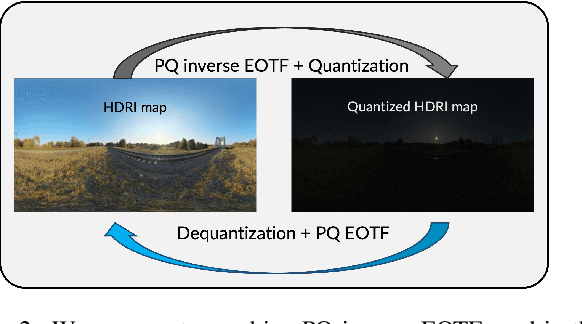

Abstract:In this paper, we present EdgeRelight360, an approach for real-time video portrait relighting on mobile devices, utilizing text-conditioned generation of 360-degree high dynamic range image (HDRI) maps. Our method proposes a diffusion-based text-to-360-degree image generation in the HDR domain, taking advantage of the HDR10 standard. This technique facilitates the generation of high-quality, realistic lighting conditions from textual descriptions, offering flexibility and control in portrait video relighting task. Unlike the previous relighting frameworks, our proposed system performs video relighting directly on-device, enabling real-time inference with real 360-degree HDRI maps. This on-device processing ensures both privacy and guarantees low runtime, providing an immediate response to changes in lighting conditions or user inputs. Our approach paves the way for new possibilities in real-time video applications, including video conferencing, gaming, and augmented reality, by allowing dynamic, text-based control of lighting conditions.
AUEditNet: Dual-Branch Facial Action Unit Intensity Manipulation with Implicit Disentanglement
Apr 10, 2024Abstract:Facial action unit (AU) intensity plays a pivotal role in quantifying fine-grained expression behaviors, which is an effective condition for facial expression manipulation. However, publicly available datasets containing intensity annotations for multiple AUs remain severely limited, often featuring a restricted number of subjects. This limitation places challenges to the AU intensity manipulation in images due to disentanglement issues, leading researchers to resort to other large datasets with pretrained AU intensity estimators for pseudo labels. In addressing this constraint and fully leveraging manual annotations of AU intensities for precise manipulation, we introduce AUEditNet. Our proposed model achieves impressive intensity manipulation across 12 AUs, trained effectively with only 18 subjects. Utilizing a dual-branch architecture, our approach achieves comprehensive disentanglement of facial attributes and identity without necessitating additional loss functions or implementing with large batch sizes. This approach offers a potential solution to achieve desired facial attribute editing despite the dataset's limited subject count. Our experiments demonstrate AUEditNet's superior accuracy in editing AU intensities, affirming its capability in disentangling facial attributes and identity within a limited subject pool. AUEditNet allows conditioning by either intensity values or target images, eliminating the need for constructing AU combinations for specific facial expression synthesis. Moreover, AU intensity estimation, as a downstream task, validates the consistency between real and edited images, confirming the effectiveness of our proposed AU intensity manipulation method.
INFAMOUS-NeRF: ImproviNg FAce MOdeling Using Semantically-Aligned Hypernetworks with Neural Radiance Fields
Dec 23, 2023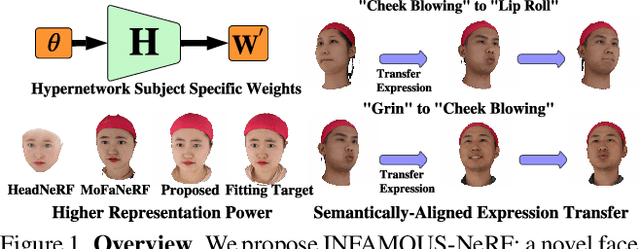
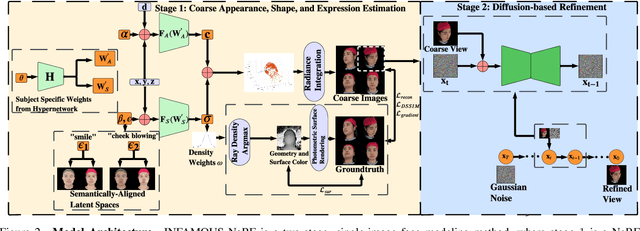

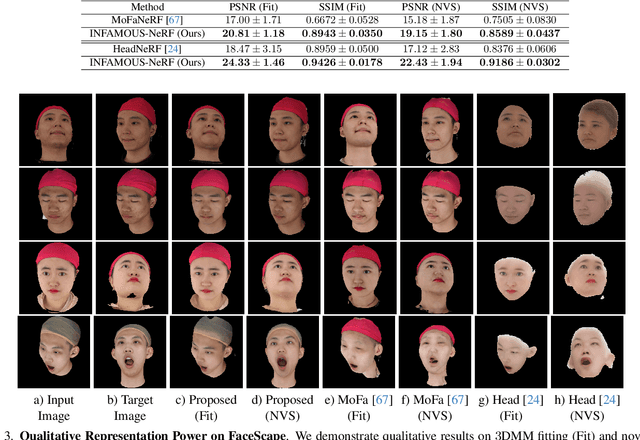
Abstract:We propose INFAMOUS-NeRF, an implicit morphable face model that introduces hypernetworks to NeRF to improve the representation power in the presence of many training subjects. At the same time, INFAMOUS-NeRF resolves the classic hypernetwork tradeoff of representation power and editability by learning semantically-aligned latent spaces despite the subject-specific models, all without requiring a large pretrained model. INFAMOUS-NeRF further introduces a novel constraint to improve NeRF rendering along the face boundary. Our constraint can leverage photometric surface rendering and multi-view supervision to guide surface color prediction and improve rendering near the surface. Finally, we introduce a novel, loss-guided adaptive sampling method for more effective NeRF training by reducing the sampling redundancy. We show quantitatively and qualitatively that our method achieves higher representation power than prior face modeling methods in both controlled and in-the-wild settings. Code and models will be released upon publication.
PVP: Personalized Video Prior for Editable Dynamic Portraits using StyleGAN
Jun 29, 2023Abstract:Portrait synthesis creates realistic digital avatars which enable users to interact with others in a compelling way. Recent advances in StyleGAN and its extensions have shown promising results in synthesizing photorealistic and accurate reconstruction of human faces. However, previous methods often focus on frontal face synthesis and most methods are not able to handle large head rotations due to the training data distribution of StyleGAN. In this work, our goal is to take as input a monocular video of a face, and create an editable dynamic portrait able to handle extreme head poses. The user can create novel viewpoints, edit the appearance, and animate the face. Our method utilizes pivotal tuning inversion (PTI) to learn a personalized video prior from a monocular video sequence. Then we can input pose and expression coefficients to MLPs and manipulate the latent vectors to synthesize different viewpoints and expressions of the subject. We also propose novel loss functions to further disentangle pose and expression in the latent space. Our algorithm shows much better performance over previous approaches on monocular video datasets, and it is also capable of running in real-time at 54 FPS on an RTX 3080.
GSMorph: Gradient Surgery for cine-MRI Cardiac Deformable Registration
Jun 26, 2023Abstract:Deep learning-based deformable registration methods have been widely investigated in diverse medical applications. Learning-based deformable registration relies on weighted objective functions trading off registration accuracy and smoothness of the deformation field. Therefore, they inevitably require tuning the hyperparameter for optimal registration performance. Tuning the hyperparameters is highly computationally expensive and introduces undesired dependencies on domain knowledge. In this study, we construct a registration model based on the gradient surgery mechanism, named GSMorph, to achieve a hyperparameter-free balance on multiple losses. In GSMorph, we reformulate the optimization procedure by projecting the gradient of similarity loss orthogonally to the plane associated with the smoothness constraint, rather than additionally introducing a hyperparameter to balance these two competing terms. Furthermore, our method is model-agnostic and can be merged into any deep registration network without introducing extra parameters or slowing down inference. In this study, We compared our method with state-of-the-art (SOTA) deformable registration approaches over two publicly available cardiac MRI datasets. GSMorph proves superior to five SOTA learning-based registration models and two conventional registration techniques, SyN and Demons, on both registration accuracy and smoothness.
ReDirTrans: Latent-to-Latent Translation for Gaze and Head Redirection
May 19, 2023Abstract:Learning-based gaze estimation methods require large amounts of training data with accurate gaze annotations. Facing such demanding requirements of gaze data collection and annotation, several image synthesis methods were proposed, which successfully redirected gaze directions precisely given the assigned conditions. However, these methods focused on changing gaze directions of the images that only include eyes or restricted ranges of faces with low resolution (less than $128\times128$) to largely reduce interference from other attributes such as hairs, which limits application scenarios. To cope with this limitation, we proposed a portable network, called ReDirTrans, achieving latent-to-latent translation for redirecting gaze directions and head orientations in an interpretable manner. ReDirTrans projects input latent vectors into aimed-attribute embeddings only and redirects these embeddings with assigned pitch and yaw values. Then both the initial and edited embeddings are projected back (deprojected) to the initial latent space as residuals to modify the input latent vectors by subtraction and addition, representing old status removal and new status addition. The projection of aimed attributes only and subtraction-addition operations for status replacement essentially mitigate impacts on other attributes and the distribution of latent vectors. Thus, by combining ReDirTrans with a pretrained fixed e4e-StyleGAN pair, we created ReDirTrans-GAN, which enables accurately redirecting gaze in full-face images with $1024\times1024$ resolution while preserving other attributes such as identity, expression, and hairstyle. Furthermore, we presented improvements for the downstream learning-based gaze estimation task, using redirected samples as dataset augmentation.
Face Relighting with Geometrically Consistent Shadows
Mar 30, 2022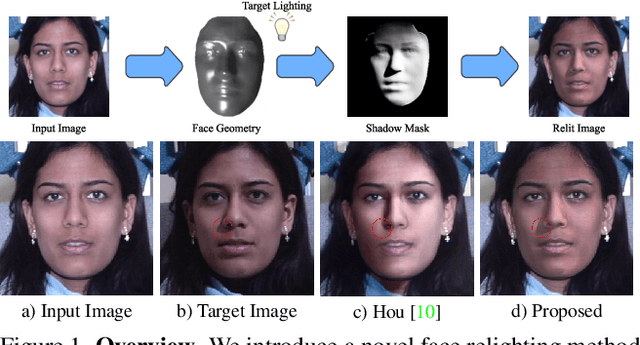
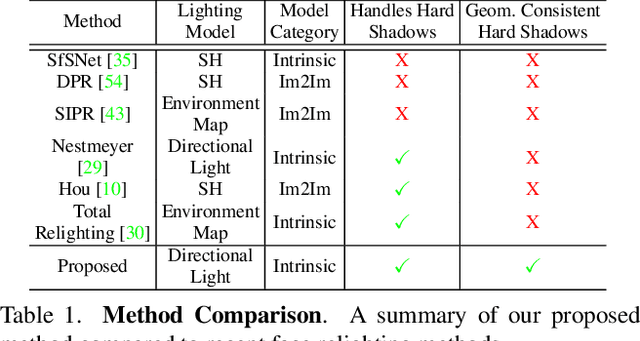
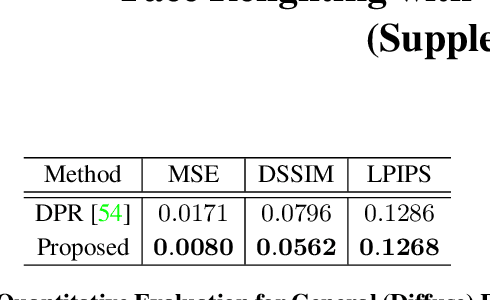
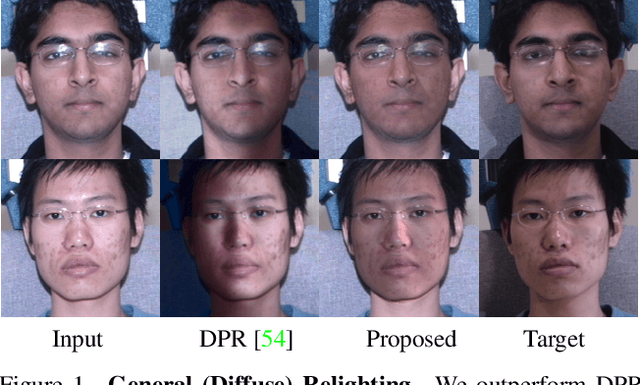
Abstract:Most face relighting methods are able to handle diffuse shadows, but struggle to handle hard shadows, such as those cast by the nose. Methods that propose techniques for handling hard shadows often do not produce geometrically consistent shadows since they do not directly leverage the estimated face geometry while synthesizing them. We propose a novel differentiable algorithm for synthesizing hard shadows based on ray tracing, which we incorporate into training our face relighting model. Our proposed algorithm directly utilizes the estimated face geometry to synthesize geometrically consistent hard shadows. We demonstrate through quantitative and qualitative experiments on Multi-PIE and FFHQ that our method produces more geometrically consistent shadows than previous face relighting methods while also achieving state-of-the-art face relighting performance under directional lighting. In addition, we demonstrate that our differentiable hard shadow modeling improves the quality of the estimated face geometry over diffuse shading models.
 Add to Chrome
Add to Chrome Add to Firefox
Add to Firefox Add to Edge
Add to Edge